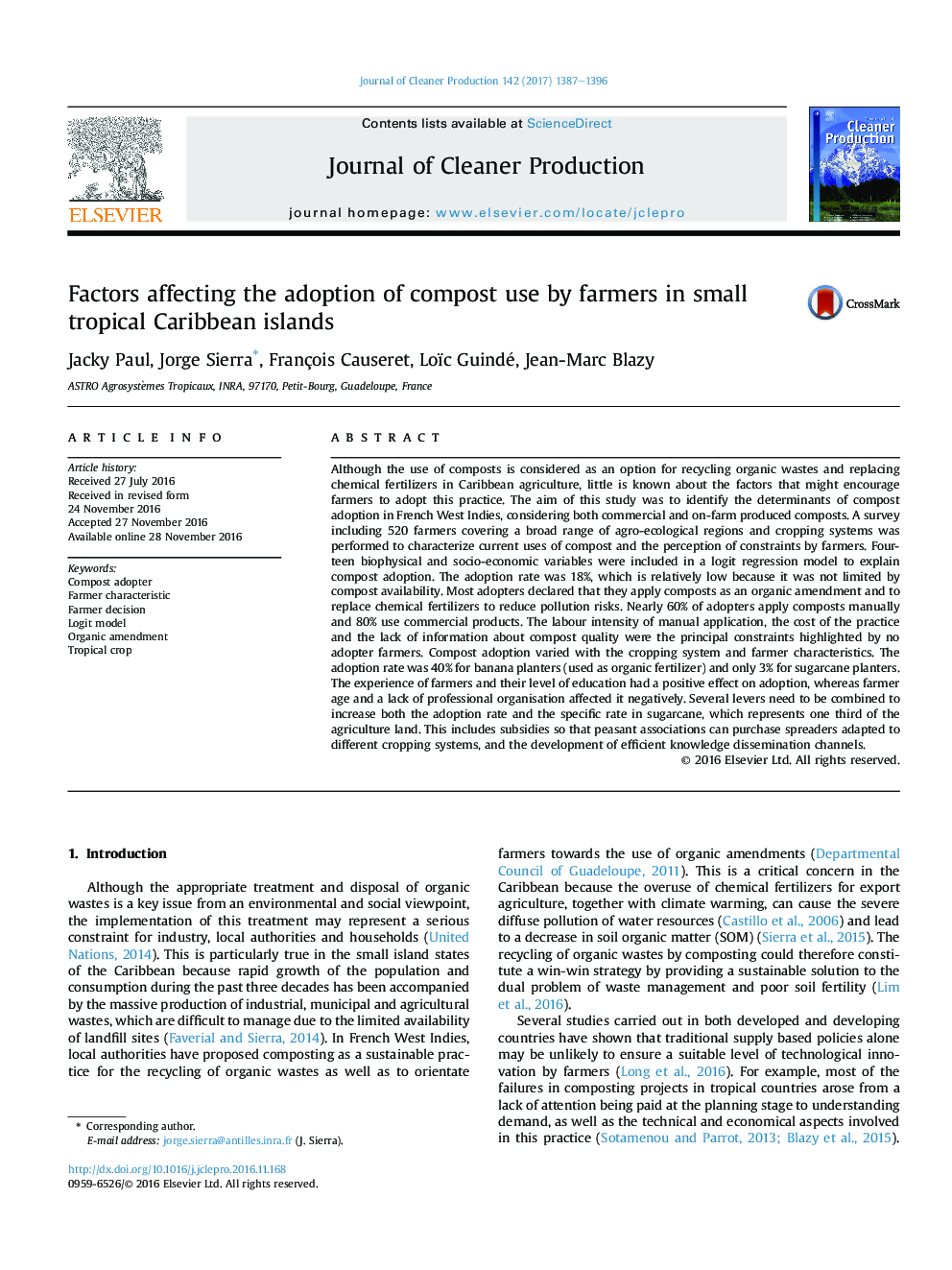| کد مقاله | کد نشریه | سال انتشار | مقاله انگلیسی | نسخه تمام متن |
|---|---|---|---|---|
| 5480319 | 1399315 | 2017 | 10 صفحه PDF | دانلود رایگان |
عنوان انگلیسی مقاله ISI
Factors affecting the adoption of compost use by farmers in small tropical Caribbean islands
ترجمه فارسی عنوان
عوامل موثر بر پذیرش استفاده از کمپوست توسط کشاورزان در جزایر کوچک جزایر کارائیب استوایی
دانلود مقاله + سفارش ترجمه
دانلود مقاله ISI انگلیسی
رایگان برای ایرانیان
ترجمه چکیده
اگرچه استفاده از کمپوست به عنوان یک گزینه برای بازیافت زباله های زیستی و جایگزینی کودهای شیمیایی در کشاورزی کارائیب در نظر گرفته می شود، اما در مورد عواملی که ممکن است کشاورزان را به استفاده از این عمل تشویق کند، کمی شناخته شده است. هدف از این مطالعه شناسایی عوامل تعیین کننده کمپوست در ادبیات غرب غربی فرانسه با توجه به کمپوست های تجاری و مزرعه ای است. یک نظرسنجی از 520 کشاورز که طیف وسیعی از مناطق زراعی و زراعی و سیستم های کشت را پوشش می دهد، برای توصیف کاربرد فعلی کمپوست و ادراک محدودیت ها توسط کشاورزان انجام شد. چهارده متغیر بیوفیزیکی و اجتماعی-اقتصادی در یک مدل رگرسیون منطقی برای توضیح تصویب کمپوست گنجانده شده است. نرخ پذیرش 18٪ بود که نسبتا کم است، زیرا کمپوست در دسترس نبود. اکثر متقاضیان اعلام کردند که کمپوست را به عنوان یک اصلاح ارگانی اعمال می کنند و برای جایگزینی کودهای شیمیایی برای کاهش آلودگی ها استفاده می شود. تقریبا 60 درصد متقاضیان کمپوست را به صورت دستی و 80 درصد از محصولات تجاری استفاده می کنند. شدت اشتغال کاربرد دستی، هزینه عمل و کمبود اطلاعات در مورد کیفیت کمپوست، محدودیت های اصلی بود که توسط هیچ کشاورز پذیرفته نشد. تصویب کمپوست با سیستم کشت و ویژگی های مزرعه متفاوت بود. نرخ پذیرش برای مزارع موز (که به عنوان کود آلی استفاده می شود) 40٪ بود و فقط 3٪ برای کاشت نیشکر. تجربه کشاورزان و سطح تحصیلات آنها تأثیر مثبتی بر پذیرش داشت، در حالی که سن کشاورزان و نبود سازمان حرفه ای آن را منفی می دانستند. اهرم های چندگانه باید ترکیب شوند تا میزان پذیرش و نرخ ویژه در نیشکر، که یک سوم از زمین های کشاورزی را نشان می دهد، افزایش یابد. این شامل یارانه ها می شود، به طوری که انجمن های دهقانان می توانند پخش کننده های سازگار با سیستم های مختلف تولید و توسعه کانال های انتشار دانش کارآمد را خریداری کنند.
موضوعات مرتبط
مهندسی و علوم پایه
مهندسی انرژی
انرژی های تجدید پذیر، توسعه پایدار و محیط زیست
چکیده انگلیسی
Although the use of composts is considered as an option for recycling organic wastes and replacing chemical fertilizers in Caribbean agriculture, little is known about the factors that might encourage farmers to adopt this practice. The aim of this study was to identify the determinants of compost adoption in French West Indies, considering both commercial and on-farm produced composts. A survey including 520 farmers covering a broad range of agro-ecological regions and cropping systems was performed to characterize current uses of compost and the perception of constraints by farmers. Fourteen biophysical and socio-economic variables were included in a logit regression model to explain compost adoption. The adoption rate was 18%, which is relatively low because it was not limited by compost availability. Most adopters declared that they apply composts as an organic amendment and to replace chemical fertilizers to reduce pollution risks. Nearly 60% of adopters apply composts manually and 80% use commercial products. The labour intensity of manual application, the cost of the practice and the lack of information about compost quality were the principal constraints highlighted by no adopter farmers. Compost adoption varied with the cropping system and farmer characteristics. The adoption rate was 40% for banana planters (used as organic fertilizer) and only 3% for sugarcane planters. The experience of farmers and their level of education had a positive effect on adoption, whereas farmer age and a lack of professional organisation affected it negatively. Several levers need to be combined to increase both the adoption rate and the specific rate in sugarcane, which represents one third of the agriculture land. This includes subsidies so that peasant associations can purchase spreaders adapted to different cropping systems, and the development of efficient knowledge dissemination channels.
ناشر
Database: Elsevier - ScienceDirect (ساینس دایرکت)
Journal: Journal of Cleaner Production - Volume 142, Part 4, 20 January 2017, Pages 1387-1396
Journal: Journal of Cleaner Production - Volume 142, Part 4, 20 January 2017, Pages 1387-1396
نویسندگان
Jacky Paul, Jorge Sierra, François Causeret, Loïc Guindé, Jean-Marc Blazy,
